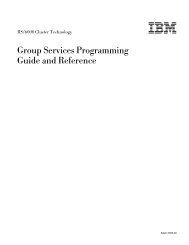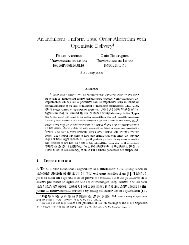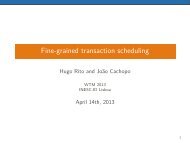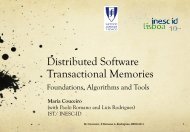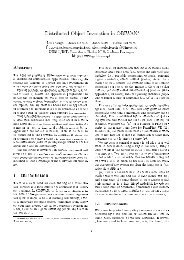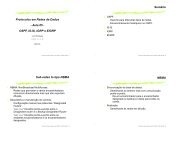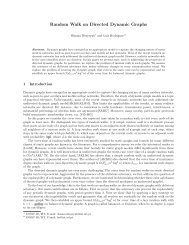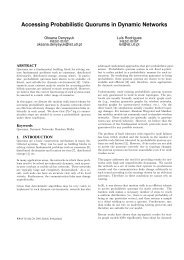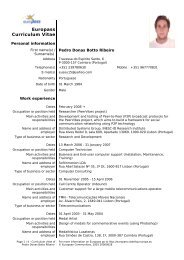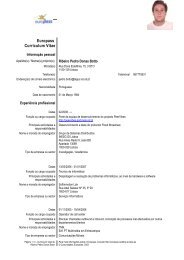Selfish and Malicious Behavior in Delay-Tolerant Networks
Selfish and Malicious Behavior in Delay-Tolerant Networks
Selfish and Malicious Behavior in Delay-Tolerant Networks
Create successful ePaper yourself
Turn your PDF publications into a flip-book with our unique Google optimized e-Paper software.
as different protocols perform better or worse depend<strong>in</strong>g on the type of misbehavior. This<br />
suggests the need for further research <strong>in</strong> the area.<br />
The paper is organized as follows. Section 2 presents the rout<strong>in</strong>g protocols considered<br />
<strong>in</strong> the paper <strong>and</strong> discusses related work. Section 3 presents the types of misbehavior<br />
studied. Section 4 describes the simulation model. Section 5 presents the evaluation of DTN<br />
rout<strong>in</strong>g protocols with a variable number of misbehav<strong>in</strong>g nodes. Section 6 concludes the<br />
paper.<br />
2. DTN Rout<strong>in</strong>g Protocols <strong>and</strong> Related Work<br />
Direct Delivery [6] <strong>and</strong> First Contact [7] are s<strong>in</strong>gle copy DTN rout<strong>in</strong>g protocols where only<br />
one copy of each message exists <strong>in</strong> the network. In Direct Delivery, the message is kept <strong>in</strong><br />
the source <strong>and</strong> delivered only to the f<strong>in</strong>al dest<strong>in</strong>ation, if the nodes meet. In First Contact, the<br />
message is forwarded to the first node encountered <strong>and</strong> deleted. The message is forwarded<br />
until it reaches the <strong>in</strong>tended dest<strong>in</strong>ation.<br />
The Epidemic [8] rout<strong>in</strong>g protocol is an unlimited-copy rout<strong>in</strong>g protocol as nodes may<br />
forward messages to any node they come <strong>in</strong> contact with. When two nodes come <strong>in</strong>to<br />
communication range, they exchange a summary vector conta<strong>in</strong><strong>in</strong>g <strong>in</strong>formation about<br />
messages that they have not yet seen. The receiv<strong>in</strong>g node decides whether it accepts the<br />
message or not. This decision is taken, for example by not carry<strong>in</strong>g messages for a certa<strong>in</strong><br />
dest<strong>in</strong>ation node, or of a certa<strong>in</strong> size. The buffer size <strong>and</strong> hop count field limit the amount<br />
of resources consumed through Epidemic Rout<strong>in</strong>g.<br />
In many real environments, encounters between nodes are not r<strong>and</strong>om, but follow a<br />
predictable pattern. Mobile Ubiquitous LAN Extensions (MULEs) [9] are mobile agents<br />
(vehicles or animals) that when <strong>in</strong> close range pick, buffer <strong>and</strong> drop off data, carry<strong>in</strong>g data<br />
between remote locations. To exemplify a pattern, the Data MULEs <strong>in</strong> [10], meet with<br />
higher probability certa<strong>in</strong> Data MULEs. The Probabilistic Rout<strong>in</strong>g Protocol us<strong>in</strong>g History<br />
of Encounters <strong>and</strong> Transitivity (PRoPHET) protocol [11] uses a probabilistic metric:<br />
delivery predictability, that attempts to estimate, based on node encounter history, which<br />
node has the higher probability of successful delivery of a message to the f<strong>in</strong>al dest<strong>in</strong>ation.<br />
When two nodes are <strong>in</strong> communication range, a new message copy is transferred only if the<br />
other node has a better probability of deliver<strong>in</strong>g it to the dest<strong>in</strong>ation.<br />
MaxProp [12] attempts to transfer all messages not held by the other node, when it is <strong>in</strong><br />
communication range. The protocol uses acknowledgments to clear the rema<strong>in</strong><strong>in</strong>g copies of<br />
a message <strong>in</strong> the network when it is received by the dest<strong>in</strong>ation node. When nodes discover<br />
each other, MaxProp exchanges messages <strong>in</strong> a specific priority order, tak<strong>in</strong>g <strong>in</strong>to account<br />
message hop counts <strong>and</strong> the delivery likelihood to a dest<strong>in</strong>ation based on previous<br />
encounters. New packets are assigned higher priority, <strong>and</strong> the protocol attempts to avoid<br />
reception of duplicate packets.<br />
In the Resource Allocation Protocol for Intentional DTN (RAPID) [13], rout<strong>in</strong>g packets<br />
are opportunistically replicated until a copy reaches the dest<strong>in</strong>ation node. The protocol<br />
models DTN rout<strong>in</strong>g as a utility-driven resource allocation problem. The rout<strong>in</strong>g metric is a<br />
per-packet utility function. When nodes are <strong>in</strong> communication range, RAPID replicates the<br />
packet that results locally <strong>in</strong> the highest <strong>in</strong>crease <strong>in</strong> utility. The correspond<strong>in</strong>g utility Ui of<br />
packet i, is def<strong>in</strong>ed as the expected contribution of i to the given utility rout<strong>in</strong>g metric.<br />
RAPID is composed of three core components: (1) a selection algorithm determ<strong>in</strong>es which<br />
packets to replicate given their utilities when nodes are <strong>in</strong> communication range, (2) the<br />
<strong>in</strong>ference algorithm, that given a rout<strong>in</strong>g metric estimates the utility of a packet, <strong>and</strong> (3) a<br />
control channel, that propagates metadata required by the <strong>in</strong>ference algorithm.<br />
Spray <strong>and</strong> Wait [14] is an n-copy rout<strong>in</strong>g protocol with two phases: (1) spray phase,<br />
where a message created by the source node is <strong>in</strong>itially spread by the source to encountered<br />
nodes until the n copies are exhausted; (2) wait phase, where every node conta<strong>in</strong><strong>in</strong>g a copy



